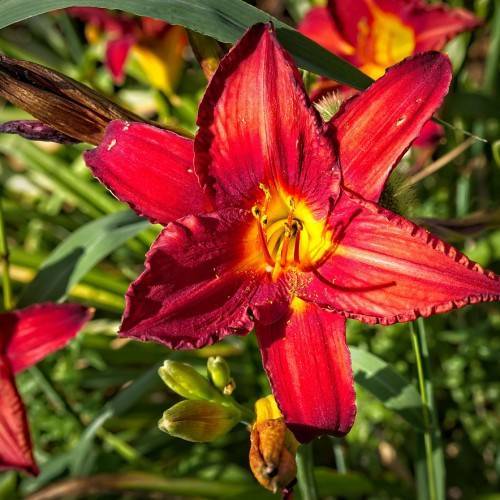
tetraploid daylily
Hemerocallis 'Doug's Red Mercedes'
Cycle:
Herbaceous Perennial
Watering:
Average
Hardiness Zone:
3 - 9
Flowers:
Flowers
Sun:
Full sun,part shade
Leaf:
Yes
Growth Rate:
High
Maintenance:
Low
Care Level:
Medium
watering
For optimal growth, water tetraploid daylily (Hemerocallis 'Doug's Red Mercedes') regularly, with approximately 1 inch of water per week. During the growing season, water the plants deeply, once a week with a soaking that penetrates up to 8 inches deep. In the winter, water less frequently, about every 2 to 3 weeks. During times of extreme drought or heat, check the soil moisture frequently to ensure that the daylilies are receiving water on a more regular basis.
sunlight
Tetraploid daylily (Hemerocallis 'Doug's Red Mercedes') requires 6 to 8 hours of full sunlight each day for optimal growth. Morning sunlight is best as it provides the plant with the necessary energy for the development of its delicate flowers. To get the most out of the sunlight, it's best to place this plant in an area that receives 6 to 8 hours of direct sunlight per day during the summer. For best blooms, avoid locations that are too shady. If the plant is in a spot that does not get enough sun, it will not bloom, and the overall growth of the plant will be reduced.
pruning
Tetraploid daylily (Hemerocallis 'Doug's Red Mercedes') should be pruned in the early spring before the season's new growth. Prune the plant back to about 6" above the soil surface and remove all dead, diseased, or damaged foliage. Pruning will encourage the plant to produce even more leaves, flowers, and healthier new growing tips. Pruning Daylilies in the early spring will also help control the size and shape of the plant. When pruning, it is important to make sure to cut at an angle so that there is not a straight line of cuts, which can damage the plant. You can also selectively prune away some of the foliage to promote more even growth and to allow more air and sunlight to reach the center of the plant.
